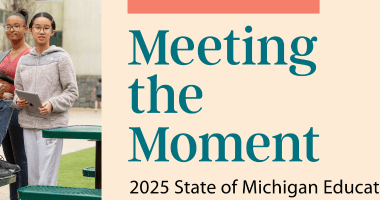Bridge Michigan Opinion | Michigan’s education proposals show progress; more is needed
For the first time in Michigan history, state Senate leaders are proposing to create a much fairer school funding formula that would rightfully consider the concentration of poverty in individual school districts across the state, from the Upper Peninsula to the Indiana border.
Yet as we applaud state policymakers’ commitment to all students and public education in general, we also urge leaders to make sure these proposals are the beginning — not the end — of a conversation on fair school funding. Additionally, investments should be coupled with accountability and transparency for addressing opportunity and outcomes gaps for students.
Indeed, Michigan has a tremendous opportunity to make transformative change now — while laying the foundation for even more impact for our students’ futures and the futures of generations of Michigan children to come. That’s sorely needed in a state where students in under-resourced communities and schools, including many Black, Latino and Arab-American students, those from low-income backgrounds, rural communities, English learners and students with disabilities, often do not have the same educational opportunities as their peers.
Let’s first consider that Michigan’s system of funding schools has created some of the worst resource gaps in the nation between wealthy and low-income districts. Currently, our state provides just 11.5 percent more funding for students who are underserved, including those from low-income backgrounds. This low, flat, weight puts Michigan among the worst states for fairness, ranking 20th among 28 states with similar funding formulas.
Both the Michigan House and Senate budget proposals would make significant improvements in this area. And notably, the state Senate proposes a first-ever “Opportunity Index.” This index would ensure students in districts with higher rates of poverty would receive higher weighted funding to close longstanding opportunity gaps.
As leaders who reflect the political and regional diversity of our great state, we have come together to lead a growing statewide coalition — the Michigan Partnership for Equity and Opportunity — that is championing the needs of all Michigan students, including the Opportunity Index, as well as the needs of English Learners and students with disabilities.
Modeled after leading education states such as Massachusetts, the Opportunity Index would make a critical difference in ensuring students in school districts with deeper concentrated poverty levels would have access to resources that students in wealthier districts can access.
The Senate proposal marks historic progress for such students and school districts. It should not stop there. To build upon this proposal, we urge the legislature to make plans for far greater weights that research suggests would actually close opportunity gaps for the next generation of children.
Meanwhile, the House proposes to enshrine a long-term funding goal for students who qualify for at-risk funding with a weight of an additional 35 percent. We urge policymakers to ensure these weights will be the floor – not the ceiling – for funding that’s needed to support diverse students’ needs. This is particularly true as Michigan begins a deeper conversation about its school funding system.
Additionally, Michigan has an opportunity to make far greater progress for funding the needs of English Learners, who have been largely left out of the funding conversation. Indeed, Michigan woefully underfunds these students, allocating only between 1 and 11 percent additional funding to support their additional needs. This is, tragically, among the lowest in the country among states with similar systems.
The Senate proposes doubling funding for English Learners — and that is a significant step. We applaud Senate leaders for acknowledging years of neglect for these learners, and also urge them to plan for funding weights that will transform the opportunities available to these students. We propose creating weights of 80 to 100 percent for these students based on language proficiency.
We also want to applaud both House and Senate leaders for proposing to fully fund the foundation allowance for students with disabilities. These students have long been underfunded, leaving a gap between what local districts pay to provide services to these students and the amount of dollars they receive from the state.
All of Michigan’s students are just as bright as students in other states, and they deserve the same opportunities for success in school and life. It is time our state acknowledges longstanding inequities that have harmed many children, whether they are from low-income backgrounds, rural communities, Black, Latino or Arab-American students, English learners, and students with disabilities.
Let’s keep our sleeves rolled up for the work ahead — and center the children who are the most under-resourced in all school funding conversations — to make sure every child in Michigan has the funding and resources to flourish and thrive.
This opinion piece appeared in Bridge Michigan. Alice Thompson is chair of the Detroit branch of the NAACP education committee. Mike Jandernoa chairs the West Michigan Policy Forum Policy Committee. Amber Arellano is executive director of The Education Trust-Midwest. The trio co-chair the Michigan Partnership for Equity and Opportunity.









